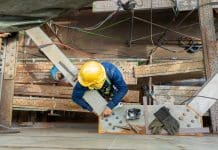The choice of sustainable building materials is a powerful lever for more low-carbon buildings. Assessing these materials requires digital tools and a digital way of thinking
Climate change has been a key focus for the architecture, engineering, construction and operation (AEC/O) industry for some time. However, recently released figures from the United Nations Environment Programme (UNEP) send a stark warning: the industry is not on track to achieve its 2050 decarbonisation targets. According to UNEP’s 2022 Global Status Report for Buildings & Construction, the sector still accounted for around 37% of energy and process-related CO2 emissions in 2021.
It’s clear that more needs to be done. While no single approach ensures total decarbonisation, the environmental impacts of new construction projects need to be assessed at a very early stage in order to minimise the building’s carbon footprint across its entire lifecycle.
In particular, choosing sustainable building materials wherever possible is an excellent start. By assessing the options early in the planning process, more sustainable building materials can be specified, which reduce the carbon emissions generated during manufacturing, construction and operation.
Typically, this is done using a lifecycle assessment (LCA) and relies on Building Information Modelling (BIM). By regarding the entire building lifecycle, the Nemetschek Group and its 13 brands offer digital solutions providing a holistic, data-driven approach that is necessary to further drive the transformation of the construction industry.
Assessing sustainable building materials with LCA
LCA is an established method used to identify the environmental risks of construction products, services and even manufacturing processes. Doing so makes it possible to compare different design options and ensure that the most sustainable solution is chosen. As the decisions made at the earliest stages have some of the biggest impacts on a building’s environmental performance, it is critical to use these assessment methods at the start of a project.
Many different tools are available to undertake lifecycle assessment, each with different levels of granularity and complexity. Essentially, the tools draw environmental information from databases, which is then used to calculate various environmental impacts of the building’s components for the whole lifecycle of the structure. This provides a consistent basis for making design decisions that can optimise the performance of the building across all stages.
Choosing sustainable building materials
While an LCA considers the entire lifecycle of a material – from extraction, manufacture, utilisation and disposal – different materials have different considerations that affect their sustainability. For example, timber is often considered to be more environmentally friendly than concrete. Yet to maximise the ecological benefits of timber, it needs to be sustainably produced from well-managed forests, optimally designed to maximise itsservice life and appropriately disposed of at the end of its lifespan.
Similarly, the Global Warming Potential (GWP) of bamboo is much less than traditional construction materials such as steel and concrete, but this can be significantly affected by the cultivation practices employed and energy supply used during processing and manufacturing.
Even for traditional construction materials, there is variability. For example, the environmental impact of concrete can be affected by any admixtures. These can extend the service life of the concrete or enable alternative and recycled materials to be used, which can lessen the material’s carbon footprint during its lifecycle. The type of concrete used also significantly affects the carbon emissions generated by the material over its lifespan.
How digital design supports LCA
A BIM model is a good foundation for undertaking an LCA. Because BIM models are semantically rich, much of the information required for performing an LCA is already contained in the model. Using openBIM formats, such as IFC, it is much easier to exchange information using standardised representations (including element types, material layers and properties), which allows mapping elements to their corresponding records in the desired ecological database to estimate their environmental impact.
Of course, at an early design stage, there are numerous uncertainties that are yet to be resolved. An approach for overcoming those uncertainties could be by specifying materials more generically rather than specifically – such as using “concrete” rather than indicating the strength and type of concrete (eg C30). This can mean that an accurate LCA is more difficult to achieve at an early stage of the project when options are being evaluated.
However, using different uncertainty mitigation approaches assist in estimating the impact of the decisions being made. There are research projects underway that are investigating how best to address this challenge, such as by using data from completed projects or finding ways to enrich the BIM data and automatically map its elements to an LCA profile or database. As these projects develop, the LCA’s evaluations will become increasingly accurate.
Towards a digital way of thinking
Creating a precise LCA is a complex task, but a critical one if the AEC/O industry is to reach its decarbonisation goals. Digital tools can help make the assessment easier, and new methods are continuously evolving to streamline the process further.
For example, researchers are investigating how to improve the sound insulation of timber frames at an earlier stage in the design process.
Typically, these analyses are undertaken when the project is already in detailed design. The problem with this is that these analyses can identify issues which usually require expensive and time-consuming changes. By using openBIM, the researchers have been able to shift the planning of the building physics, including acoustic analysis, to earlier stages, where any changes have less of an impact.
Another area of development is how to increase the accuracy of calculated environmental impacts, such as embodied carbon or energy efficiency.
While these calculations can be carried out at an early stage, their precision is hindered as there are often still many unresolved uncertainties at this stage of the design. The relative “completeness” of the BIM model can often suggest that the design is more finalised than it really is. For example, material classification may be limited, the location or function of materials may be unknown, or there can be deficiencies in the decision process that hamper the design.
As the industry races to reach net zero, it’s clear that digital tools are a key tool for decarbonisation. Also, collaboration with academia and research can provide innovations to drive sustainability. It needs to be one of the goals of the construction industry, that even at an early stage, it must be possible to make more informed decisions based on digital tools – for better environmental outcomes.
Desiree Goldstein
Corporate Communication
Nemetschek Group
*Please note: This is a commercial profile

















